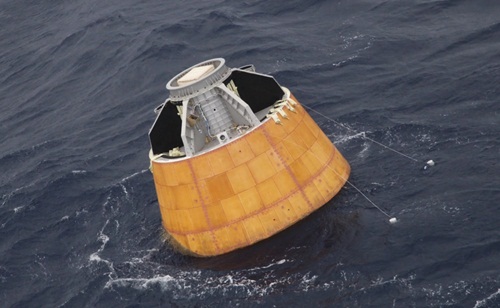The Indian Space Research Organisation (Isro) today successfully flight-tested a Crew Escape System, a major technology demonstration, and the first in a series of critical technology development relevant for human spaceflight.
The Crew Escape System is an emergency escape measure designed to quickly pull the crew module along with the astronauts to a safe distance from the launch vehicle in the event of a launch abort.
The first test (Pad Abort Test) demonstrated the safe recovery of the crew module in case of any exigency at the launch pad taking India another step forward with its human spaceflight programme.
After a smooth countdown of 5 hours, the Crew Escape System along with the simulated crew module with a mass of 12.6 tonnes, lifted off at 07.00 am (IST) at the opening of the launch window from its pad at Satish Dhawan Space Centre, Sriharikota today. The test was over in 259 seconds, during which the Crew Escape System along with crew module soared skyward, then arced out over the Bay of Bengal and floated back to Earth under its parachutes about 2.9 km from Sriharikota, Isro stated in release.
The crew module reached an altitude of nearly 2.7 km under the power of its seven specifically designed quick acting solid motors to take away the crew module to a safe distance without exceeding the safe g-levels. Nearly 300 sensors recorded various mission performance parameters during the test flight.
Three recovery boats were used to retrieve the module as part of the recovery protocol.
While the Indian Space Research Organisation (ISRO) has not made manned space missions one of their highest priorities, the agency has been quietly proceeding with work on a capsule that would launch atop the GSLV Mk.III rocket and carry a crew of two into orbit.
The project’s most high-profile test came three and a half years ago, when the Crew Module Atmospheric Reentry Experiment (CARE) successfully demonstrated that the spacecraft could withstand the rigors of atmospheric reentry.
But, unlike CARE, which was carried to an altitude of 126 kilometers (78.3 miles, 68.0 nautical miles) on the first test flight of the GSLV Mk.III, today’s flight took place entirely within Earth’s atmosphere.
While the test had a two-hour launch window, running from 06:00 to 08:00 IST (00:30 to 02:30 UTC), the target liftoff time was understood to be 07:00 local (01:30 UTC). The mission had previously been scheduled to fly last year, but Isro has not announced the reason for it being delayed.
While Isro has not made many details of the mission public, the capsule flying the abort test is reported to be fitted with an altimeter and satellite navigation receivers to track its position. It was to use India’s NavIC, or IRNSS, navigation system as well as the US Global Positioning System (GPS), augmented by GAGAN transmitters on Indian geostationary satellites.
Telemetry was to be transmitted to the ground directly, and also uplinked to the GSAT-6 satellite in geostationary orbit. The test vehicle stands 14 meters tall, with a mass of 12,500 kg.





















